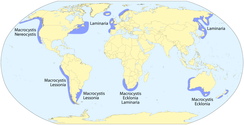
Back غابة أعشاب البحر Arabic Лес водарасцей Byelorussian Šume algi BS Bosc de varec Catalan Chaluhový les Czech Tangskov Danish Kelpwald German Algaro Esperanto Bosque de algas Spanish جنگل کتانجک Persian
| Marine habitats |
|---|
 |
| Coastal habitats |
| Ocean surface |
| Open ocean |
| Sea floor |
Kelp forests are underwater areas with a high density of kelp, which covers a large part of the world's coastlines. Smaller areas of anchored kelp are called kelp beds. They are recognized as one of the most productive and dynamic ecosystems on Earth.[1][2] Although algal kelp forest combined with coral reefs only cover 0.1% of Earth's total surface, they account for 0.9% of global primary productivity.[3] Kelp forests occur worldwide throughout temperate and polar coastal oceans.[1] In 2007, kelp forests were also discovered in tropical waters near Ecuador.[4]

"I can only compare these great aquatic forests...with the terrestrial ones in the intertropical regions. Yet if in any country a forest was destroyed, I do not believe so nearly so many species of animals would perish as would here, from the destruction of kelp. Amidst the leaves of this plant numerous species of fish live, which nowhere else could find food or shelter; with their destruction the many cormorants and other fishing birds, the otters, seals and porpoise, would soon perish also; and lastly, the Fuegian[s]...would...decrease in numbers and perhaps cease to exist.
– Charles Darwin, 1 June 1834, Tierra del Fuego, Chile[5]
Physically formed by brown macroalgae, kelp forests provide a unique habitat for marine organisms[6] and are a source for understanding many ecological processes. Over the last century, they have been the focus of extensive research, particularly in trophic ecology, and continue to provoke important ideas that are relevant beyond this unique ecosystem. For example, kelp forests can influence coastal oceanographic patterns[7] and provide many ecosystem services.[8]
However, the influence of humans has often contributed to kelp forest degradation. Of particular concern are the effects of overfishing nearshore ecosystems, which can release herbivores from their normal population regulation and result in the overgrazing of kelp and other algae.[9] This can rapidly result in transitions to barren landscapes where relatively few species persist.[10][11] Already due to the combined effects of overfishing and climate change,[12] kelp forests have all but disappeared in many especially vulnerable places, such as Tasmania's east coast and the coast of Northern California.[13][14] The implementation of marine protected areas is one management strategy useful for addressing such issues, since it may limit the impacts of fishing and buffer the ecosystem from additive effects of other environmental stressors.
- ^ a b Mann, K.H. 1973. Seaweeds: their productivity and strategy for growth. Science 182: 975-981.
- ^ Pessarrodona, A; Assis, J; Filbee-Dexter, K; Burrows, M T; Gattuso, J-P; Duarte, C.M.; Krause-Jensen, D; Moore, P.J.; Smale, D.A.; Wernberg, T (23 July 2020). "Global Seaweed Productivity". Science Advances. 8 (37): eabn2465. doi:10.1126/sciadv.abn2465. hdl:10754/681467. PMC 9473579. PMID 36103524.
- ^ See Fig. 3 in Blakemore, Robert (2018). "Non-Flat Earth Recalibrated for Terrain and Topsoil". Soil Systems. 2 (4): 64. doi:10.3390/soilsystems2040064.
- ^ Graham, M.H., B.P. Kinlan, L.D. Druehl, L.E. Garske, and S. Banks. 2007. Deep-water kelp refugia as potential hotspots of tropical marine diversity and productivity. Proceedings of the National Academy of Sciences 104: 16576-16580.
- ^ Darwin, C. 1909. The Voyage of the Beagle. The Harvard Classics Volume 29. New York, USA: P.F. Collier & Son Company.
- ^ Christie, H., Jørgensen, N.M., Norderhaug, K.M., Waage-Nielsen, E., 2003. Species distribution and habitat exploitation of fauna associated with kelp (Laminaria hyperborea) along the Norwegian coast. Journal of the Marine Biological Association of the UK 83, 687-699.
- ^ Jackson, G.A. and C.D. Winant. 1983. Effect of a kelp forest on coastal currents. Continental Shelf Report 2: 75-80.
- ^ Steneck, R.S., M.H. Graham, B.J. Bourque, D. Corbett, J.M. Erlandson, J.A. Estes and M.J. Tegner. 2002. Kelp forest ecosystems: biodiversity, stability, resilience and future. Environmental Conservation 29: 436-459.
- ^ Sala, E., C.F. Bourdouresque and M. Harmelin-Vivien. 1998. Fishing, trophic cascades, and the structure of algal assemblages: evaluation of an old but untested paradigm. Oikos 82: 425-439.
- ^ Dayton, P.K. 1985a. Ecology of kelp communities. Annual Review of Ecology and Systematics 16: 215-245.
- ^ Norderhaug, K.M., Christie, H., 2009. Sea urchin grazing and kelp re-vegetation in the NE Atlantic. Marine Biology Research 5, 515-528
- ^ Filbee-Dexter, Karen; Feehan, Colette J.; Scheibling, Robert E. (2016-02-03). "Large-scale degradation of a kelp ecosystem in an ocean warming hotspot". Marine Ecology Progress Series. 543: 141–152. Bibcode:2016MEPS..543..141F. doi:10.3354/meps11554. ISSN 0171-8630.
- ^ Morton, Adam; Cordell, Marni; Fanner, David; Ball, Andy; Evershed, Nick. "The dead sea: Tasmania's underwater forests disappearing in our lifetime". the Guardian. Retrieved 2020-10-22.
- ^ Steinbauer, James. "What Will It Take to Bring Back the Kelp Forest? - Bay Nature Magazine". Bay Nature. Retrieved 2020-10-22.
© MMXXIII Rich X Search. We shall prevail. All rights reserved. Rich X Search